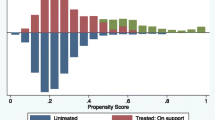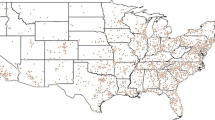Abstract
Title charges are costs that are related to establishing and insuring title in a real estate transaction. These charges vary considerably and include title insurance premiums and other fees involved in closing a mortgage loan. This study analyzes the variation in title charges using data from almost 3,000 FHA-insured, 30-year fixed-rate home purchase loans in five metropolitan areas. Even after controlling for cost-related and other characteristics, more than one-half of the variation in title charges remains unexplained in four of the five markets. Substantial differences in charges between settlement agents suggest that consumers would benefit by shopping for settlement services.
Similar content being viewed by others
Notes
The large variation in title charges could result from the relatively non-competitive nature of the title insurance market. Researchers argue that title charges are held substantially above cost by local industry practice, state regulation, and the infrequency with which consumers shop around (Woodward and Hall 2010). Critics allege that in competing for the business of real estate agents and underwriters, settlement agents have less incentive to satisfy what they perceive to be a captive customer (Dumm et al. 2007; GAO 2007; Owen 1977; White 1984). Even more sympathetic analyses highlight such “reverse competition” as a genuine problem that is inherent in the market and requires a solution (Roussel and Rosenberg 1981).
HUD selected the May 21-June 30 closing date period based on an examination of interest rate trends. The goal was to select a period during which interest rates were stable.
For another aspect of state regulatory policy and a good discussion of the title insurance industry, see Jaffee (2006).
An abstract is a collection of legal documents that are associated with a title and that are compiled by the title agent.
Regressions that trimmed the top and bottom 0.5 and 2 % of values were also estimated to ensure that the findings are robust to different trimming strategies.
We interviewed two industry specialists who worked in non-profit research and advocacy organizations, one representative from a title insurance trade association, one settlement agent in each of four of our study markets (Phoenix, Chicago, Sacramento, and Broward County), and three settlement agents in Philadelphia.
We also estimate regressions in levels and use quadratic versions of house price to capture any non-linearities. These models are not shown here, but the results are largely comparable to the preferred log specification.
Alternative median neighborhood age specifications are discussed in Sect. 5, but are not ultimately included in reported output.
Models with five settlement agent fixed effects are also estimated to determine the robustness of the results to the number of fixed effects specified. The results are consistent between the two specifications. Models with ten settlement agent fixed effects are presented here to describe the range of title charges within a larger share of the market.
The YSP is the compensation that is paid by the lender to the mortgage broker (but generally passed onto the borrower in lower cash origination charges) for selling a borrower a loan at a higher interest rate than what that lender could otherwise have qualified for.
The coefficient of variation of home prices is 0.40 in Philadelphia, which is much higher than in the other four markets: Cook County, 0.30; Sacramento County, 0.24; Broward County, 0.21; Maricopa County, 0.19 (not shown in table).
One variable—the amount that is paid to the real estate agents that were involved in the transaction—is equal to zero for between 15 and 30 % of cases, depending on the market. Instead of dropping this significant portion of the sample, we take the log of the reported payment to real estate agents plus one dollar. Results are robust to whether one dollar is added before logging the payment to real estate agents or other amounts such as 10 or 25 dollars are added. These are likely cases where no real estate agent is used. Elder et al. (2000) report that in a 1996 survey of home buyers, 16 % of transactions do not use a real estate agent.
An F-test revealed that the estimated regression models for the two components of total title charges (premiums plus endorsements and other charges) are significantly different in all five counties.
To test whether age exhibited a non-linear association with costs (for example, with neighborhoods of relatively young or relatively old residents both at a disadvantage relative to more average block group median age levels) we substituted dummy variables for younger, middle, and older median age block groups (roughly corresponding to the interquartile range and the lowest and highest quartile). No notable non-linearities were identified. The categorical version (not shown) is consistent with the continuous version in showing that neighborhoods with younger residents pay higher title charges. Median block group age was also interacted with average block group household earnings, but this was statistically insignificant.
References
Birnbaum, B. (2005). An analysis of competition in the California title insurance and Escrow industry. Report to the California Insurance Commissioner. Retrieved from: http://www.insurance.ca.gov/0400-news/0200-studies-reports/upload/CATitleCompetitionReport0512Public.pdf
The Chicago Bar Association v. Quinlan and Tyson, Inc. 34 Ill. 2d 117, 1966.
Dumm, R. E., Macpherson, D. A., & Sirmans, G. S. (2007). The title insurance industry: Examining a decade of growth. Journal of Insurance Regulation, 25(4), 24–51.
Eaton, J. W. (2009, May 28). Title insurance reform: A long overlooked target of opportunity—The governor and the legislature should embrace it. Testimony to the hearing on title insurance rate regulation under the auspices of the Pennsylvania Insurance Commission. Harrisburg, PA.
Eaton, J., & Eaton, D. (2007). The American Title Insurance Industry: How a Cartel Fleeces the American Consumer. New York: NYU Press.
Elder, Harold, Zumpano, Leonard, & Baryla, Edward. (2000). Buyer-brokers: Do they make a difference? Their influence on selling price and search duration. Real Estate Economics, 28(2), 337–362.
Jaffee, D. (2006). Monoline restrictions, with applications to mortgage insurance and title insurance. Review of Industrial Organization, 28(2), 83–108.
Lacko, James, & Pappalardo, Janis. (2010). The failures and promise of mandated consumer mortgage disclosures: Evidence from qualitative interviews and a controlled experiment with mortgage borrowers. The American Economic Review, 100(2), 516–521.
Lewis, H. (2014). Closing Costs Study. Bankrate.com. Retrieved from: http://www.bankrate.com/finance/mortgages/closing-costs/closing-costs-by-state.aspx
McKernan, S., Wissoker, D., Ratcliffe, C., Van Order, B., & Scott, M. (2009). Descriptive analysis of FHA settlement charges. Report prepared for the U.S. Department of Housing and Urban Development. Washington, DC: The Urban Institute.
Owen, B. M. (1977). Kickbacks, specialization, price fixing, and efficiency in residential real estate markets. Stanford Law Review, 29(5), 931–967.
Roussel, H. L., & Rosenberg, M. K. (1981). The high price of ‘Reform’: Title insurance rates and the benefits of rating bureaus. Journal of Risk and Insurance, 48(4), 638–648.
Turner, M. A., Ross, S. L., Galster, G. C., & Yinger, J. (2002). Discrimination in metropolitan housing markets: National results from phase I HDS2000. Report prepared for the U.S. Department of Housing and Urban Development. Washington, DC: The Urban Institute.
U.S. Government Accountability Office. (2007). Title insurance: Actions needed to improve oversight of the title industry and better protect consumers. Washington, DC: GAO.
White, L. J. (1984). The title insurance industry, reverse competition, and controlled business: A different view. Journal of Risk and Insurance, 51(2), 308–319.
Woodward, S. E. (2008). A study of closing costs for FHA mortgages. Report prepared for the U.S. Department of Housing and Urban Development, Washington, DC: The Urban Institute.
Woodward, S. E., & Hall, R. (2010). Consumer confusion in the mortgage market: Evidence of less than a perfectly transparent and competitive market. American Economic Review: Papers and Proceedings, 100, 511–515.
Acknowledgments
This article is based on a report funded by the U.S. Department of Housing and Urban Development Order Number C-CHI-01027CHI-T0001. The views expressed are those of the authors and should not be attributed to the Urban Institute, its trustees, or its funders. We thank William Reid, William Reeder, Kurt Usowski, and all of HUD’s Office of Policy Development and Research staff for their helpful suggestions. The authors also thank the settlement agents, industry representatives, and title insurance experts who contributed to our understanding of the industry, as well as Larry White and two anonymous reviewers for their comments on an earlier draft.
Author information
Authors and Affiliations
Corresponding author
Rights and permissions
About this article
Cite this article
Feinberg, R.M., Kuehn, D., McKernan, SM. et al. Explaining Variation in Title Charges: A Study of Five Metropolitan Residential Real Estate Markets. Rev Ind Organ 46, 145–167 (2015). https://doi.org/10.1007/s11151-014-9441-0
Published:
Issue Date:
DOI: https://doi.org/10.1007/s11151-014-9441-0




